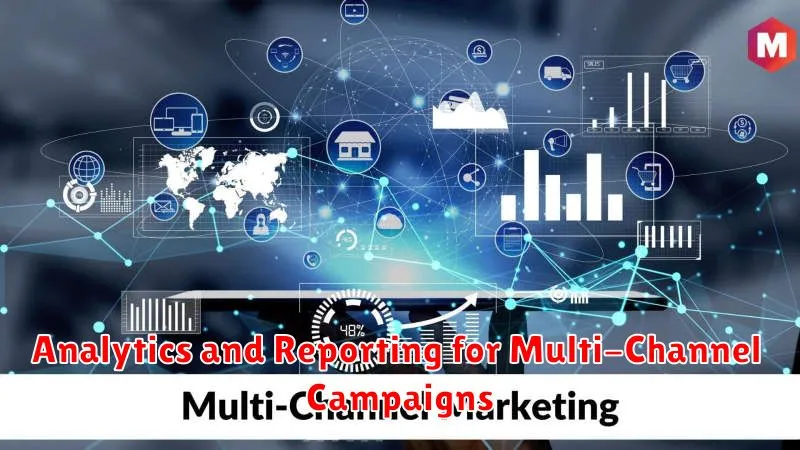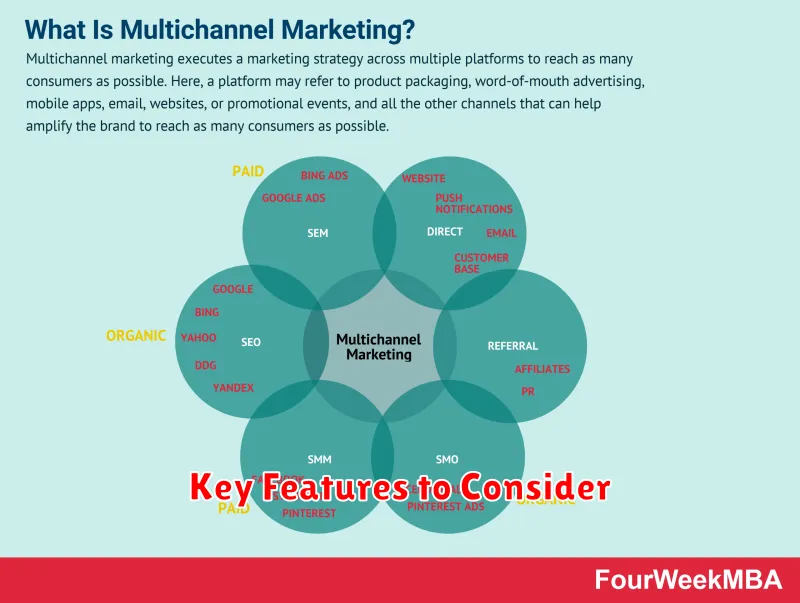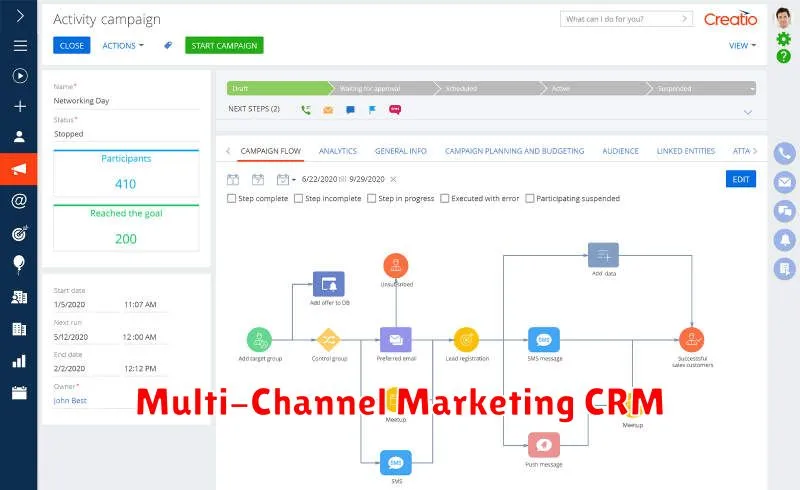Choosing the right CRM (Customer Relationship Management) system is crucial for businesses looking to implement successful multi-channel marketing campaigns. A robust CRM can help you manage customer interactions across various channels, such as email, social media, website, and mobile apps, providing a unified view of your customers. This allows you to personalize communications, segment your audience, and optimize your marketing efforts for higher engagement and conversion rates. With so many CRM solutions available, finding the perfect fit for your business requires careful consideration of your specific needs and goals. This article will guide you through the key factors to evaluate when choosing a CRM for your multi-channel marketing campaigns.
The Importance of Multi-Channel Marketing
In today’s digital age, consumers are constantly bombarded with messages from various sources. To effectively reach your target audience and achieve business goals, a multi-channel marketing approach is essential. This strategy involves leveraging multiple channels to connect with customers at different touchpoints throughout their journey.
Benefits of Multi-Channel Marketing
Multi-channel marketing offers numerous advantages, including:
- Increased Reach: By utilizing multiple channels, you can expand your reach and connect with a wider audience.
- Enhanced Brand Awareness: Consistent messaging across channels reinforces your brand and increases visibility.
- Improved Customer Engagement: Engaging with customers on their preferred channels leads to stronger relationships and loyalty.
- Greater Conversion Rates: Multi-channel campaigns provide multiple opportunities for customers to interact and convert.
- Better Data Insights: Tracking performance across channels provides valuable data to optimize your marketing efforts.
Key Channels to Consider
There are various channels to incorporate into your multi-channel strategy, including:
- Email Marketing: Effective for nurturing leads, sending promotions, and providing valuable content.
- Social Media Marketing: Engage with customers, build community, and share relevant content.
- Search Engine Optimization (SEO): Increase organic website traffic through targeted keywords and content optimization.
- Pay-Per-Click (PPC) Advertising: Drive targeted traffic to your website through paid search campaigns.
- Content Marketing: Provide valuable and engaging content to attract and inform your audience.
- Mobile Marketing: Optimize your marketing efforts for mobile devices to reach a growing segment of consumers.
Creating a Successful Multi-Channel Strategy
To create an effective multi-channel marketing strategy, consider the following:
- Define your target audience: Understand their demographics, interests, and online behavior.
- Establish clear goals: Determine what you want to achieve with your multi-channel campaigns.
- Select the right channels: Choose channels that align with your target audience and goals.
- Create consistent messaging: Ensure your brand voice and messaging are consistent across all channels.
- Track and analyze performance: Monitor key metrics and make adjustments as needed.
Conclusion
Multi-channel marketing is essential for businesses seeking to reach their target audience, build brand awareness, and drive conversions. By leveraging multiple channels effectively, you can create a seamless customer experience and achieve your marketing goals.
Integrating CRM with Marketing Channels
In today’s competitive business landscape, businesses need to leverage every tool at their disposal to reach their target audience and drive sales. One crucial aspect of achieving this goal is seamlessly integrating CRM (Customer Relationship Management) with various marketing channels. This strategic integration allows businesses to optimize their marketing efforts, personalize customer experiences, and ultimately, boost conversions.
Benefits of Integrating CRM with Marketing Channels
Integrating CRM with marketing channels offers a plethora of benefits, including:
- Enhanced Customer Segmentation: By merging customer data from CRM with marketing analytics, businesses can create highly specific customer segments based on demographics, behavior, preferences, and purchase history. This granular segmentation allows for tailored marketing messages and campaigns that resonate with each segment.
- Personalized Customer Experiences: CRM data provides valuable insights into individual customer interactions, preferences, and purchase patterns. This information enables businesses to deliver personalized marketing messages, offers, and recommendations, fostering stronger customer relationships and loyalty.
- Improved Marketing Campaign Effectiveness: By integrating CRM with marketing automation tools, businesses can automate email campaigns, social media posts, and other marketing initiatives based on customer interactions and behavior. This automation streamlines marketing processes, saves time and resources, and increases campaign efficiency.
- Data-Driven Insights: The combined data from CRM and marketing channels provides a comprehensive view of customer behavior, allowing businesses to track campaign performance, measure ROI, and identify areas for improvement. This data-driven approach empowers businesses to optimize their marketing strategies and maximize their return on investment.
Strategies for Successful Integration
Successfully integrating CRM with marketing channels requires a well-defined strategy and careful implementation. Here are some key strategies to consider:
- Choose the Right CRM and Marketing Automation Tools: Select CRM and marketing automation platforms that seamlessly integrate and offer features aligned with your business objectives. Ensure compatibility between the chosen platforms to ensure smooth data flow and efficient operations.
- Establish a Clear Data Flow: Define how customer data will be collected, stored, and shared between the CRM and marketing channels. Implement data synchronization processes to maintain data consistency and accuracy.
- Develop a Comprehensive Integration Plan: Outline the steps involved in integrating CRM with marketing channels, including data migration, system configuration, user training, and testing. This plan ensures a smooth transition and minimizes disruptions to your operations.
- Monitor and Optimize: Regularly monitor the performance of your integrated CRM and marketing channels. Track key metrics, analyze results, and make adjustments to your strategies as needed to ensure continuous improvement and maximum effectiveness.
Conclusion
Integrating CRM with marketing channels is essential for businesses looking to enhance customer relationships, personalize experiences, and boost sales. By leveraging the power of CRM data and marketing automation, businesses can gain valuable insights, optimize their marketing efforts, and drive sustainable growth. By implementing the strategies outlined above, businesses can unlock the full potential of CRM integration and create a truly customer-centric marketing approach.
Email Marketing Integration
Email marketing is a powerful tool that can be used to build relationships with customers, promote products and services, and drive sales. When integrated with other marketing channels, it can be even more effective.
There are many ways to integrate email marketing with other channels, such as:
- Website: Integrate email signup forms on your website to capture leads and build your email list. You can also use email to promote your website content and drive traffic to your site.
- Social Media: Use email to promote your social media channels and encourage engagement. You can also use social media to collect email addresses from followers and build your email list.
- Blog: Use email to send out notifications about new blog posts and encourage readers to subscribe to your blog. You can also use email to collect feedback on your blog posts and improve your content.
- Paid Advertising: Integrate email marketing with your paid advertising campaigns to capture leads and nurture them through the sales funnel. You can also use email to retarget users who have visited your website but haven’t made a purchase.
By integrating email marketing with other channels, you can create a more seamless and effective customer experience. This can lead to increased engagement, conversions, and sales.
Here are some of the benefits of integrating email marketing:
- Increased brand awareness: Email marketing can help you reach a wider audience and build brand awareness.
- Improved customer engagement: Integrating email marketing with other channels can help you create a more personalized and engaging customer experience.
- Higher conversion rates: Email marketing can help you drive traffic to your website and convert more leads into customers.
- Increased ROI: Email marketing is a cost-effective marketing channel that can provide a high return on investment.
If you’re not already integrating email marketing with other channels, now is the time to start. It’s one of the most effective ways to reach your target audience and achieve your marketing goals.
tag to encapsulate the article. *
tag for the heading “Social Media Integration”. *
tags for each paragraph. * tags for important keywords. * Optional use of other HTML tags like , , or for emphasis, italics, or links. * Blog article style. For example, please provide text like this: > Social media integration is essential for modern businesses. It allows companies to connect with their customers, build brand awareness, and drive sales.
By integrating social media into your website, you can create a seamless experience for users.
This can be done by adding social media sharing buttons, embedding social media feeds, or running social media contests. I will then format it as a blog article for you.
Website and Landing Page Integration
Website and landing page integration is a crucial aspect of digital marketing that involves seamlessly connecting your website with dedicated landing pages to optimize user experience and drive conversions. By integrating these two elements, you can create a cohesive and effective online presence that guides visitors through the customer journey.
Benefits of Website and Landing Page Integration
Integrating your website and landing pages offers numerous advantages, including:
- Improved User Experience: A seamless transition between your website and landing pages provides a consistent and intuitive experience for visitors, reducing friction and encouraging them to complete desired actions.
- Enhanced Conversion Rates: By directing traffic to targeted landing pages optimized for specific goals, you can increase the likelihood of conversions, such as sign-ups, purchases, or lead generation.
- Effective Lead Nurturing: Landing pages can capture valuable lead information, while website integration allows you to nurture these leads through personalized content and follow-up campaigns.
- Data-Driven Insights: Integrating website and landing pages provides valuable data about user behavior, enabling you to analyze performance, optimize campaigns, and make informed decisions.
Key Considerations for Integration
When integrating your website and landing pages, it’s important to consider the following:
- Clear Call to Action (CTA): Ensure your landing pages have a prominent CTA that encourages visitors to take the desired action.
- Consistent Branding: Maintain a cohesive brand identity across your website and landing pages, using consistent design elements and messaging.
- Optimized Content: Tailor landing page content to specific target audiences and objectives, focusing on key benefits and solutions.
- Mobile Responsiveness: Ensure your landing pages are optimized for mobile devices, as a significant portion of traffic comes from smartphones and tablets.
- Tracking and Analytics: Implement tracking codes and analytics tools to monitor performance and gather valuable insights.
Integration Strategies
There are various approaches to integrating your website and landing pages, including:
- Pop-ups and Modals: Use pop-ups or modals on your website to promote specific landing pages and capture leads.
- Website Banners and Links: Place banners or links on your website that direct visitors to relevant landing pages.
- Content Marketing Integration: Link to landing pages within blog posts, articles, or other content marketing efforts.
- Social Media Integration: Share landing page links on social media platforms to drive targeted traffic.
- Email Marketing Integration: Include landing page links in your email campaigns to encourage click-throughs and conversions.
Conclusion
Integrating your website and landing pages is essential for optimizing user experience, driving conversions, and maximizing your online marketing efforts. By strategically connecting these elements, you can create a cohesive and effective online presence that delivers results.
Analytics and Reporting for Multi-Channel Campaigns

In today’s digital landscape, businesses are increasingly relying on multi-channel marketing campaigns to reach their target audience. This involves using a combination of channels, such as email, social media, search engine optimization (SEO), and paid advertising, to deliver a consistent message and drive conversions. However, tracking the effectiveness of multi-channel campaigns can be a daunting task.
To understand the impact of your multi-channel efforts, you need robust analytics and reporting tools. These tools provide valuable insights into how each channel is performing, how different channels interact with each other, and how your campaigns are influencing customer behavior. By leveraging analytics, you can optimize your campaigns, allocate budget effectively, and ultimately achieve your marketing goals.
Key Analytics for Multi-Channel Campaigns
Here are some key analytics to consider for your multi-channel campaigns:
- Reach: The number of unique users exposed to your campaign across different channels.
- Engagement: How users interact with your content, including clicks, shares, and time spent on your website.
- Conversions: The number of desired actions taken, such as website visits, form submissions, or purchases.
- Customer Lifetime Value (CLTV): The total revenue generated from a customer over their relationship with your business.
- Attribution: Determining which channels are responsible for driving conversions.
Reporting and Visualization
Once you have collected your data, you need to present it in a way that is easy to understand and actionable. This is where reporting and visualization tools come in. These tools can generate customizable reports, dashboards, and charts that illustrate key metrics and trends.
Some popular reporting tools include Google Analytics, Adobe Analytics, and Tableau. These tools offer features like:
- Customizable dashboards: Create dashboards that display the most important metrics for your campaigns.
- Data segmentation: Analyze data based on different criteria, such as demographics, location, or device type.
- Interactive visualizations: Use charts, graphs, and other visual elements to present data in a clear and compelling way.
Benefits of Multi-Channel Analytics
Here are some key benefits of implementing multi-channel analytics:
- Improved campaign performance: Identify which channels are most effective and allocate budget accordingly.
- Enhanced customer understanding: Gain deeper insights into customer behavior and preferences across channels.
- Data-driven decision making: Make informed decisions based on real-time data and analytics.
- Increased ROI: Optimize your marketing efforts to maximize return on investment.
Conclusion
Analytics and reporting are essential components of successful multi-channel marketing campaigns. By leveraging the right tools and data insights, you can track your progress, optimize your strategies, and achieve your marketing goals. Remember that data is only valuable if it is used to inform your decision-making and drive continuous improvement.

` tag for the overall article structure. * `
` tag for each paragraph. * `` tag for important keywords. * Other HTML tags as needed for supporting content. * Blog article-style formatting. For example, please provide me with the text you want me to format, like: “This is the title of my blog article. This is the first paragraph of my blog article. It talks about some important keywords that are relevant to the topic. This is the second paragraph. It continues the discussion and emphasizes other keywords**.” Once you provide the content, I will format it into a blog article for you.
